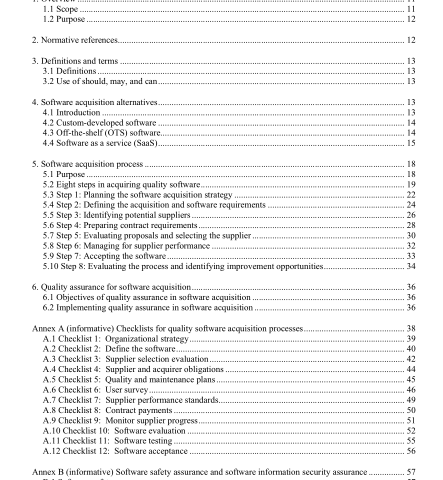IEEE 1062-2016 pdf download.IEEE Recommended Practice for Software Acquisition
4.3.1 Advantages of OTS The advantages of OTS are as follows:
Cost is less than the custom-developed option but similar to the SaaS option.
Time to initial operations is less than the custom-developed option and can be greater than the SaaS option.
Since the acquirer takes possession of the solution, the control over data and access is greater than the SaaS option and about the same as the custom-developed option.
4.3.2 Disadvantages of OTS The disadvantages of OTS are as follows:
The terms of the generally non-negotiable license agreement constrain how the solution may be used by the acquirer, possibly to the acquirer’s detriment. The solution typically includes features that attempt to enforce specific agreement terms, adding cost and complexity to the solution.
The solution may not satisfy all of the acquirer’s needs (sometimes called gaps) and it may also provide features/capabilities that are not required, not desired or even tolerable to the acquirer. The acquirer may need additional solutions, or modifications to the acquired solution, to fill these gaps. In addition, the acquirer may also need to identify and deactivate or prevent the extraneous code from activating itself.
Sometimes, the User Interface to the solution is different from the way an acquirer is currently offering a User Interface to their current users. This can sometimes/often be solved via product tailoring.
Typically, there will be a need to obtain support from the supplier for installation, activation, and maintenance.
Problem reporting can be an issue, depending on the supplier’s capability to accept and react to problem reports. In addition, the supplier may not even agree that because an acquirer alleges a problem exists that a legitimate problem actually does exist.
Product changes, both fixes and upgrades, are controlled mostly by the supplier and determined by marketplace needs. Such changes may not be consistent with the acquirer’s ongoing needs or timeframe.
It is possible for the vendor to go out of business resulting in a possible loss of data.
4.4 Software as a service (SaaS) Software as a service (SaaS) is an acquisition approach where the solution to an acquirer’s need is provided via an agreement with a supplier for access to a software product for a fixed amount of time and to use that software product remotely, via connection (wired, wireless, etc.) to the supplier’s assets. Inputs to the remote software product are transmitted to the supplier and outcomes/results/products from using the software product are transmitted back to the acquirer. This acquisition option is part of the Cloud Computing approach (NIST Special Publication 800-145 [B12]) to software (aka renting access to products, services, infrastructure, etc.) and is frequently referred to as software as a service (SaaS).
4.4.1 Advantages of SaaS
The advantages of SaaS are as follows:
Rapid access to products and services via Service Level Agreement (SLA) and ready to use solutions, more so than custom-developed or OTS.
No need to provide internal computing assets to support “building or buying” the equivalent products or services, thus reducing costs and time in prep for using solution, as compared to both custom-developed and OTS.
Typically is cheaper than custom-developed option and can be cheaper than the OTS option.
No need to take permanent ownership of the software solution, thus reducing impacts associated with such ownership (e.g., sustainment, hardware to host solution), as in the custom-developed and OTS options.
4.4.2 Disadvantages of SaaS
The disadvantages of SaaS are as follows:
The terms of the generally non-negotiable license agreement constrain how the solution may be used by the acquirer, possibly to the acquirer’s detriment. The solution typically includes features that attempt to enforce specific agreement terms, adding cost and complexity to the solution.
The solution may not satisfy all of the acquirer’s needs (sometimes called gaps) and it may also provide features/capabilities that are not required, not desired or even tolerable to the acquirer. The acquirer may need additional solutions, or modifications to the acquired solution, to fill these gaps. In addition, the acquirer may also need to identify and deactivate or prevent the extraneous code from activating itself.IEEE 1062 pdf download.IEEE 1062-2016 pdf download
IEEE 1062-2016 pdf download

Leave a Reply